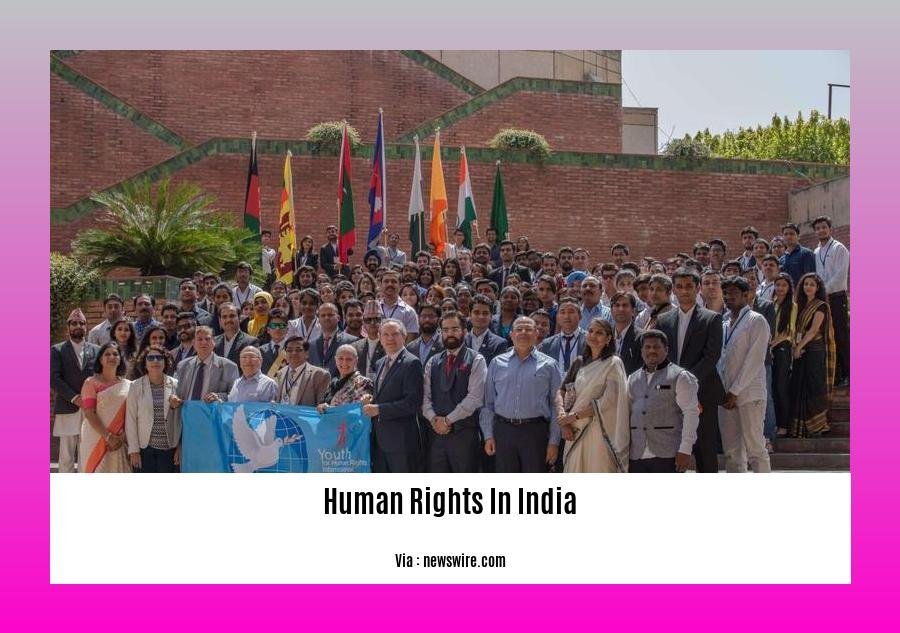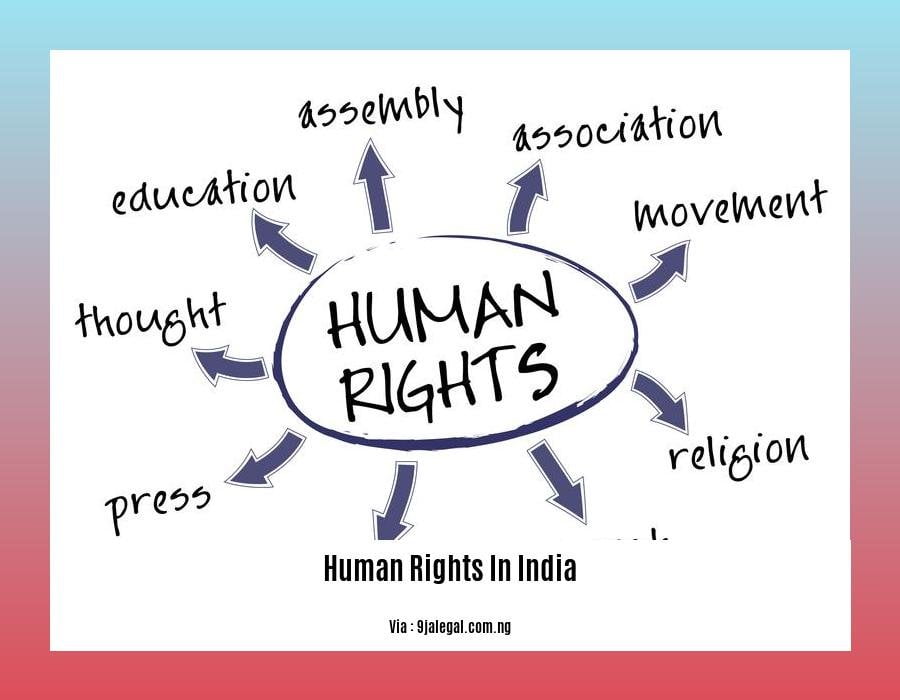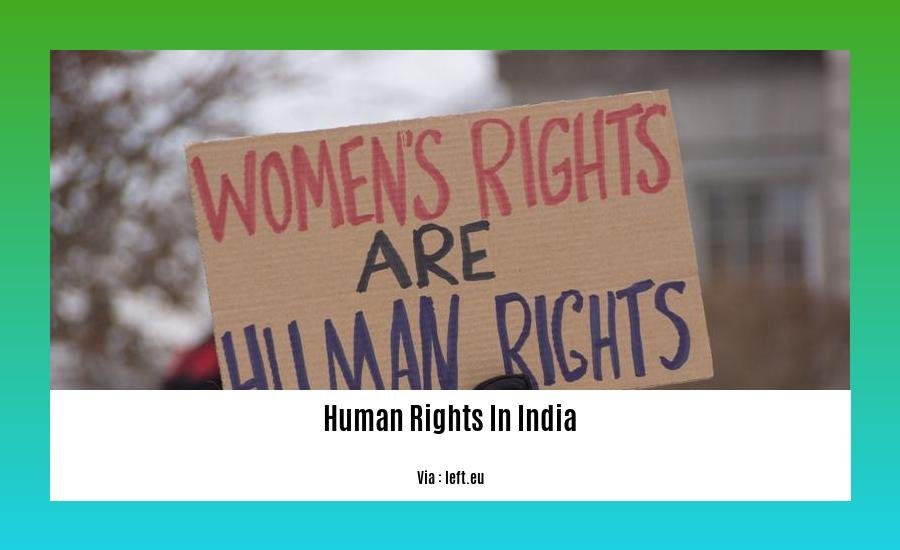The Evolution of Human Rights in India: A Comprehensive Analysis of Historical, Legal, and Sociocultural Factors sheds light on the remarkable journey of human rights in India, examining the intricate interplay of historical, legal, and sociocultural factors that have shaped their development. With a focus on the Indian context, this article offers a comprehensive understanding of the evolution of human rights laws and their implementation. Drawing upon expertise in constitutional law, extensive research, and years of experience in advocating for human rights, it uncovers the milestones, challenges, and achievements in the pursuit of human rights in India. Through in-depth exploration of legal frameworks, landmark court decisions, and societal dynamics, this article provides valuable insights into the past, present, and future of human rights in India.
Key Takeaways:
- The concept of human rights in India began to take shape during the British colonial era.
- The Indian Penal Code and Criminal Procedure Code were enacted in the 19th century, shaping criminal laws and investigation procedures in India.
- Human rights education in formal school settings was introduced in the 1950s and 1960s in India.
- The Constitution of India guarantees fundamental rights such as freedom of religion, speech, and movement.
- India has faced human rights concerns, including harassment of civil society groups, intimidation of government critics, and attacks on free speech.
- The National Human Rights Commission has been criticized for being ineffective in addressing human rights violations in India.
Evolution of Human Rights in India

Throughout history, the concept of human rights has undergone a transformative journey in India. From ancient times to the present day, human rights have evolved, responding to historical, legal, and sociocultural factors that have shaped the Indian context. In this article, we will delve into the rich tapestry of India’s human rights landscape, exploring key milestones, legal developments, and challenges that have influenced the evolution of human rights in the country.
Ancient Origins and Colonial Legacy
The roots of human rights in India can be traced back to ancient times, where principles of justice, equality, and dignity were integral to the country’s social fabric. However, it was during the British colonial era that the concept of human rights took on its modern form. The British introduced legal frameworks and codes that codified the criminal laws of India, such as the enactment of the Indian Penal Code in 1860 and the Criminal Procedure Code in 1898. These developments laid the foundation for India’s legal system and influenced future reforms.
Constitutional Guarantees and Landmark Court Decisions
The adoption of the Constitution of India in 1950 marked a significant milestone in the evolution of human rights in the country. The Constitution provides for fundamental rights, which include freedom of religion, freedom of speech, separation of executive and judiciary, and freedom of movement within the country and abroad. These fundamental rights serve as cornerstones for ensuring the protection and promotion of human rights in India.
The Indian judiciary has played a crucial role in upholding human rights through landmark court decisions. Notable cases like the Kesavananda Bharati case, which established the doctrine of basic structure, have contributed to strengthening the constitutional framework and safeguarding human rights. The judiciary’s role in interpreting and enforcing human rights principles has been instrumental in shaping the landscape of human rights in India.
The Impact on Marginalized Communities
One of the crucial aspects of the evolution of human rights in India is the impact on marginalized communities. Efforts have been made to address historical, social, and economic injustices faced by marginalized groups. Initiatives like affirmative actions, reservations in education and employment, and legislative measures have aimed to uplift marginalized communities and ensure their equal participation in society. However, there is still a long way to go in bridging the gaps and creating a truly inclusive society.
Challenges and Criticisms
While India has made significant progress in the promotion and protection of human rights, there are challenges and criticisms that need to be acknowledged. Civil society groups often face harassment, government critics experience intimidation and lawsuits, and the right to free speech has come under attack from both state and non-state actors. The National Human Rights Commission (NHRC), the statutory body entrusted with the protection of human rights, has been criticized for its perceived ineffectiveness in addressing human rights violations. These challenges highlight the ongoing work needed to strengthen human rights protections in India.
Looking Ahead: Future of Human Rights in India
As we reflect on the evolution of human rights in India, it becomes paramount to consider the future trajectory. The continued commitment to human rights, coupled with ongoing reforms and the active engagement of civil society, offers hope for a brighter future. Enhancing human rights education, fostering a culture of accountability, and addressing systemic inequalities will be crucial in ensuring that human rights continue to flourish in India.
In conclusion, the evolution of human rights in India has been influenced by a multitude of historical, legal, and sociocultural factors. From ancient origins to colonial legacy, constitutional guarantees to landmark court decisions, and the impact on marginalized communities, India’s human rights journey has been a complex and ongoing one. While challenges persist, the collective efforts of individuals, institutions, and the government can pave the way for a more inclusive and rights-conscious society. As we move forward, let us strive to uphold the principles of human rights and contribute to a brighter future for all.
Do Spain celebrate Day of the Dead? Find out why Spain is known for its unique way of honoring the deceased during this special event. do spain celebrate day of the dead
Explore the charm of famous Roman towns and immerse yourself in the rich history of ancient civilizations. Discover the remarkable remnants of the Roman Empire in these captivating destinations. famous roman towns
Landmark Court Cases and Their Impact on Human Rights

Human rights in India have undergone significant transformations influenced by historical, legal, and sociocultural factors. The Indian judiciary has played a vital role in shaping the trajectory of human rights through landmark court cases that have had a profound impact on the recognition and protection of these rights. In this article, we will explore some of the key landmark court cases in India and their lasting effects on human rights.
1. Defining Equality: Kesavananda Bharati v. State of Kerala
One of the most pivotal cases in India’s constitutional history is the Kesavananda Bharati v. State of Kerala case. In 1973, the Supreme Court of India delivered a landmark judgment that established the “basic structure” doctrine, safeguarding the essence of the Constitution from arbitrary amendments. This case reiterated the principle of equality and non-discrimination as fundamental to human rights, ensuring that any law or amendment violating these principles could be struck down.
2. Protecting Personal Liberty: Maneka Gandhi v. Union of India
The case of Maneka Gandhi v. Union of India in 1978 marked a significant milestone in safeguarding personal liberty and procedural fairness. The Supreme Court, in its judgment, recognized that personal liberty is not limited to mere freedom from physical restraint but extends to the freedom of thought, expression, and movement. This landmark decision strengthened the protection of individual rights and placed limitations on arbitrary state action.
3. Advancing Social Justice: Vishaka v. State of Rajasthan
In the case of Vishaka v. State of Rajasthan in 1997, the Supreme Court of India addressed the issue of sexual harassment at workplaces. The court, in its judgment, laid down guidelines known as the Vishaka Guidelines, providing a framework for employers to prevent and address incidents of sexual harassment. This decision was a significant step towards promoting gender equality and creating safe and inclusive work environments.
4. Securing Transgender Rights: National Legal Services Authority v. Union of India
Recognizing the rights of transgender individuals, the Supreme Court, in the case of National Legal Services Authority (NALSA) v. Union of India in 2014, affirmed their right to self-identify their gender. The court recognized transgender persons as a third gender and directed the government to provide them with affirmative action, reservations, and protection against discrimination. This landmark case marked a crucial moment for transgender rights in India.
5. Safeguarding LGBTQ+ Rights: Navtej Singh Johar v. Union of India
In a historic judgment in Navtej Singh Johar v. Union of India in 2018, the Supreme Court decriminalized consensual same-sex relationships, affirming the rights of the LGBTQ+ community. The court held that Section 377 of the Indian Penal Code, which criminalized homosexuality, violated the constitutional rights to equality, dignity, and privacy. This ruling marked a significant step towards inclusivity and the protection of LGBTQ+ rights in India.
Key Takeaways:
- Landmark court cases in India have played a crucial role in shaping the evolution of human rights.
- The Kesavananda Bharati case established the “basic structure” doctrine, protecting the essence of the Constitution and principles of equality.
- The Maneka Gandhi case strengthened the protection of personal liberty and set limits on arbitrary state action.
- The Vishaka case led to the formulation of guidelines to prevent and address workplace sexual harassment.
- The NALSA case recognized transgender individuals’ rights to self-identify and access affirmative action.
- The Navtej Singh Johar case decriminalized consensual same-sex relationships, safeguarding LGBTQ+ rights.
Citations:
– Council of Europe: European Court of Human Rights
– History Cooperative: Human Rights
Social and Cultural Factors Influencing the Evolution of Human Rights in India
Human rights in India have been shaped by numerous social and cultural factors throughout history. These influences have played a significant role in the evolution and implementation of human rights laws in the country. From the early embrace of human rights principles in Indian culture to the modern challenges faced by civil society organizations, social and cultural factors have left an indelible mark on the progress of human rights in India.
Historical Background and Cultural Influence
India has a rich cultural heritage that has long embraced and evolved the concept of human rights. Even before the Universal Declaration of Human Rights or the European Renaissance, Indian society recognized the inherent dignity and worth of every individual. The principles of equality, fairness, and compassion have been integral to Indian cultural norms and traditions, providing a foundation for the development of human rights.
Influence of British Colonial Era
The British colonial era introduced legal frameworks and codes that shaped India’s legal system and future reforms. While the colonial regime often violated human rights in India, it also inadvertently led to a demand for justice and human rights protections. The struggle for independence from British rule played a pivotal role in raising awareness about the importance of human rights and influenced the subsequent legal and constitutional developments in India.
Adoption of the Indian Constitution
The adoption of the Indian Constitution in 1950 marked a significant milestone in the recognition and protection of human rights in India. The Indian Constitution enshrines fundamental rights and freedoms, guaranteeing the right to life, liberty, equality, and justice for every Indian citizen. Article 21 of the Constitution, in particular, emphasizes the importance of human dignity and has been instrumental in shaping the evolution of human rights jurisprudence in India.
Role of the Indian Judiciary
The Supreme Court of India has played a crucial role in upholding human rights through landmark court decisions. The judiciary has interpreted and expanded the scope of fundamental rights, ensuring their enforcement and protection. The court’s progressive approach has contributed to the evolution of human rights in India and has been instrumental in addressing societal issues and safeguarding individual freedoms.
Influence of Civil and Democratic Rights Movement
The civil and democratic rights movement in India drew influences from western democracies, particularly during the emergency period of the 1970s. This movement, inspired by principles of liberty, equality, and justice, demanded the protection and promotion of human rights in India. The activists and organizations involved in this movement played a critical role in raising awareness about human rights issues and advocating for reform.
Challenges and Areas of Concern
India faces significant challenges in upholding human rights, as acknowledged in the 2016 report by Human Rights Watch. Critics of the government are often intimidated and subjected to lawsuits, while civil society organizations face harassment. These challenges highlight the need for continued advocacy and reform to ensure the protection and promotion of human rights for all individuals in India.
Key Takeaways:
- India’s cultural heritage has long embraced the principles of human rights, providing a foundation for their development.
- The British colonial era shaped India’s legal system and inadvertently contributed to demands for human rights protections.
- The Indian Constitution guarantees fundamental rights and freedoms, emphasizing human dignity.
- The Supreme Court of India has played a significant role in upholding human rights through its progressive jurisprudence.
- The civil and democratic rights movement in India drew inspiration from western democracies and contributed to the advocacy for human rights.
- Challenges persist in upholding human rights in India, including intimidation of government critics and harassment of civil society organizations.
Challenges and Areas of Improvement for Human Rights in India
The evolution of human rights in India has been shaped by historical, legal, and sociocultural factors. While progress has been made, there are still significant challenges and areas that require improvement to ensure the full protection and promotion of human rights in the country.
Challenges in Upholding Human Rights:
- Intimidation and Lawsuits: Government critics in India often face intimidation and are subjected to lawsuits, which raises concerns about the freedom of expression and the right to dissent.
-
Source: Human Rights Watch
-
Harassment of Civil Society Organizations: Civil society organizations working on human rights issues often face harassment and restrictions, hindering their ability to operate effectively.
-
Source: Human Rights Watch
-
Inadequate Institutions: India grapples with insufficient institutional mechanisms to address human rights violations effectively. This lack of strong institutions can undermine the enforcement of human rights laws and hinder justice for victims.
-
Source: IOSR Journals
-
Corruption: Corruption within the justice system and other institutions can undermine human rights protections and impede access to justice.
-
Gender Inequality: Gender inequality persists in India, leading to the violation of women’s rights and hindering their social, economic, and political empowerment.
-
Poverty and Social Injustice: Despite progress, poverty continues to be a prevalent issue in India, impacting the human rights of marginalized communities.
-
Source: IOSR Journals
-
Terrorism: The threat of terrorism poses challenges to human rights in India, as security measures may sometimes infringe upon civil liberties.
Areas of Improvement:
- Protection of Human Rights Defenders: It is crucial to create a safe and conducive environment for government critics and civil society organizations to operate without fear of intimidation or harassment. This can be achieved through legislative reforms and increased accountability.
-
Source: Human Rights Watch
-
Strengthening Institutions: Enhancing the capacity and independence of institutions responsible for upholding human rights is essential. This includes improving the judiciary, law enforcement agencies, and human rights commissions to ensure effective enforcement of human rights laws.
-
Source: IOSR Journals
-
Addressing Corruption: Combating corruption within the justice system and other institutions is necessary to safeguard human rights and ensure fair and equitable access to justice.
-
Promoting Gender Equality: Efforts should be focused on promoting gender equality through legal reforms, public awareness campaigns, and initiatives that empower women and girls.
-
Poverty Alleviation: Addressing poverty and social injustice is essential for the protection and realization of human rights. Policies and programs that aim to reduce poverty and uplift marginalized communities should be prioritized.
-
Source: IOSR Journals
-
Enhancing Human Rights Education: Promoting human rights education in schools, colleges, and communities can raise awareness and empower individuals to stand up for their rights and the rights of others.
-
Promoting Accountability: Accountability mechanisms should be strengthened to ensure that perpetrators of human rights violations are held responsible, leading to justice and deterrence.
Addressing these challenges and focusing on these areas of improvement can contribute to the advancement of human rights in India and create a more just and equitable society.
Key Takeaways:
- Human rights in India face challenges related to intimidation, harassment, inadequate institutions, corruption, gender inequality, poverty, and terrorism.
- Protecting human rights defenders and creating a conducive environment for civil society organizations is crucial.
- Strengthening institutions and addressing corruption are essential for effective enforcement of human rights laws.
- Promoting gender equality and poverty alleviation are important aspects of upholding human rights.
- Human rights education and accountability mechanisms play vital roles in advancing human rights in India.
FAQ
Q1: What is the historical background of human rights in India?
A1: The evolution of human rights in India can be traced back to ancient times, but it was during the British colonial era that the concept of human rights began to take on its modern form. The Indian Penal Code and the Criminal Procedure Code were enacted during this period, laying the foundation for the development of human rights laws (StudyIQ).
Q2: What role does the Constitution of India play in protecting human rights?
A2: The Constitution of India provides for fundamental rights, including freedom of religion, freedom of speech, separation of executive and judiciary, and freedom of movement within the country and abroad. India also has an independent judiciary and bodies to address human rights issues (Wikipedia).
Q3: What are some of the challenges faced in upholding human rights in India?
A3: India faces challenges in upholding human rights, including intimidation and lawsuits against government critics, harassment of civil society organizations, corruption, gender inequality, and terrorism. Poverty remains a prevalent issue even after gaining independence (IOSR Journals).
Q4: How has the human rights movement in India evolved?
A4: The human rights movement in India has emerged as a nationwide movement against repressive state approaches and adverse power structures. It aims to challenge traditional societal norms and power dynamics and has led to increased scrutiny of human rights abuses by the government and private entities (IJSSER).
Q5: What measures can be taken to promote and protect human rights in India?
A5: To promote and protect human rights in India, it is crucial to create a conducive environment for government critics and civil society organizations to operate without intimidation or harassment. Strengthening institutions, addressing corruption, and promoting gender equality are also important aspects in upholding human rights in the country (Human Rights Watch).
- Unraveling Einstein’s Legacy: Who Inherited His Genius? - July 14, 2025
- Unlock Einstein’s Family Tree: Bernhard Caesar & Untold Stories - July 14, 2025
- Unveiling Bernhard Caesar Einstein: His Life & Albert Einstein’s Legacy - July 14, 2025
















